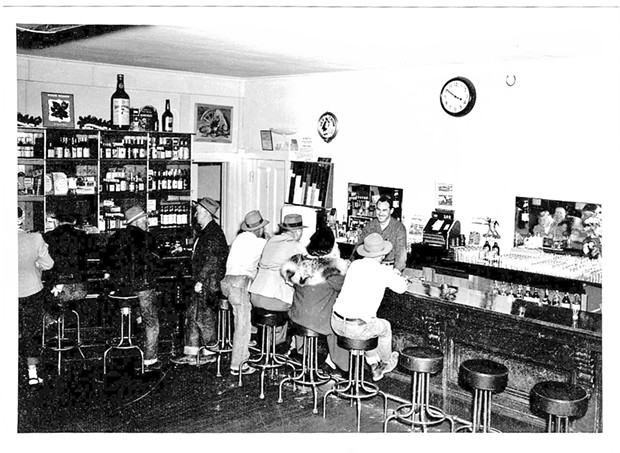
Photo courtesy of the Ferndale Museum
The bar at the Ivanhoe in 1947, likely smelling of Dungeness crab cioppino.
[
{
"name": "Top Stories Video Pair",
"insertPoint": "7",
"component": "17087298",
"parentWrapperClass": "fdn-ads-inline-content-block",
"requiredCountToDisplay": "1"
}
]
My mom's recipe for crab cioppino became well known at the Ivanhoe in Ferndale when my dad owned it in the late 1940s. They were raising my two older sisters before the rest of us were born. Maybe my mom was raising them, as my dad was a bar owner. Her recipe was locally famous and, as I was growing up, we would host cioppino feeds at our home for friends during the crab season.
She always cooked the crab live in the sauce — that is what a true cioppino is, made with a raw crab, freshly backed — thinned with lots of wine for serious sourdough bread dipping. My uncle worked for Parisian Bread in San Francisco and always supplied us with the best loaves.
Cioppino is essentially an Italian tomato sauce with wine, made to go with bread instead of pasta. Some ingredients can be borrowed from cioppino's French cousin bouillabaisse, which typically has a variety of other seafood, particularly white fish, and a fish broth base flavored with saffron and orange. Potatoes, onions and leeks are often added. There are similar dishes around the Mediterranean ports.
Italian immigrants in the late 1800s, many from the Genoa port on the Ligurian Sea on the northwest side of Italy near Morocco, would come back with a lack of catch and pass the pot around asking others to "chip in" to the cioppin (from the Genoise for "little soup"). These immigrant fisherman came to San Francisco at the turn of the century, fished off Meiggs wharf and lived in North Beach. Like back home, fishermen asked one another to add the leftover catch of the day to the pot. It could be squid, scallops, shrimp, clams or mussels, but especially Dungeness crab. Cioppino, served with a bib, became a staple of Italian restaurants in North Beach.
Many fisherman around Humboldt County were also Italians. The Lazio family, of the storied Lazio's seafood restaurant on the Eureka waterfront, was close with the Aliotos on Fisherman's Wharf and traded recipes. I'm not sure how my Swiss mother developed or learned this recipe, but she grew up with Italians on the outskirts of Ferndale.
I use two big pots and make more than the recipe below, as I like to freeze it in jars and break out a cioppino feed in the summer. Seven or eight crab should serve nine to 10 people with the sauce and bread rounding out the meal. I use extra sherry in one pot to make it sweeter. You can use a little sugar but I don't. Over the years, I have added extras to my mom's recipe, including: chili pepper and chili flakes for zip, oregano, fresh ginger root, more wine and more celery, a little red wine vinegar and sometimes saffron borrowed from that French cousin. Sadly, we haven't had fish feeds this year. But you can enjoy half the recipe now and the rest later, maybe with friends.
Dungeness Crab Cioppino
You can substitute pre-cooked crab for live, adding it to the pot later and simmer for a shorter time. It is still tasty but not quite the real thing. Serves 9-10.
Ingredients:
7-8 whole live Dungeness crab
1½ cups olive oil
3-4 onions (red or yellow), chopped
1 cup celery, chopped
12 cloves garlic, chopped
Freshly ground pepper
4 28-ounce canned tomatoes
24 ounces canned tomato sauce
5 teaspoons dry basil
1½ cups Italian flat-leaf parsley, chopped
4 bay leaves
25 whole peppercorns
6 teaspoons salt
½ bottle cheap red wine, more to taste
½ bottle sherry, more to taste
5 sprigs fresh rosemary,
In a large stock pot, sauté the olive oil, onions, celery, ground pepper and garlic over medium heat until the onions are translucent.
Add the canned tomatoes, tomato sauce, basil, Italian parsley, bay leaves and peppercorns. Stir in the salt, wine and sherry.
Bring the pot to boil over medium-high heat, then reduce the heat, cover and simmer for 20 minutes, adding more wine to thin or sherry to sweeten, if desired.
Meanwhile, wash off the live crab and crack their shells slightly, exposing the meat just a little so some of the sauce's flavor seeps into the meat while cooking.
Add the cracked crab to the bubbling sauce, turn down to low heat and simmer 4-6 hours, adding optional spices as you see fit.
Serve with lots of sourdough bread, hand towels for each guest, crab forks or crab crackers, extra bowls for the shells and lots of vino. Bibs are required.
Rod Kausen (he/him) is a retired teacher and coach.
Editor's note: This story has been updated to note that crab should be raw but backed, with the upper shell removed.Speaking of...
-

Local Commercial Dungeness Crab Season to Open in January
Dec 20, 2023 -

NCJ Preview: Drag, Birdmobiles and Sketchy Seafood
May 20, 2023 -

Local Commercial Crab Season Opener is Set
Dec 22, 2022 - More »
Comments (5)
Showing 1-5 of 5
more from the author
-
The Best of Fans
Bill and Emily Langenbach
- Oct 7, 2021
-
Gene Cotter's Basketball Jones
- Sep 16, 2021
-
To Choke
- Aug 19, 2021
- More »































